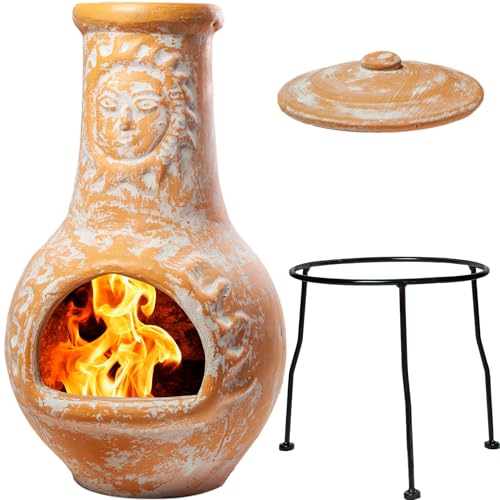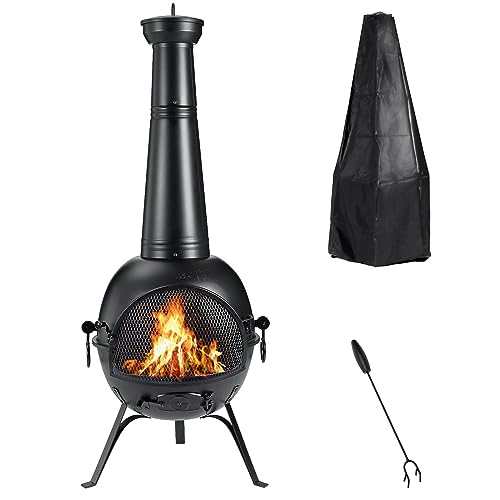자유게시판
| 제목 | The 9 Things Your Parents Taught You About Chiminea Terracotta |
|---|---|
| 작성자 | Shiela |
| 조회수 | 46회 |
| 작성일 | 24-09-29 06:44 |
| 링크 |
본문
 A chiminea Terracotta [Www.artrecord.kr] Adds Warmth and Ambiance to Your Backyard Patio
A chiminea Terracotta [Www.artrecord.kr] Adds Warmth and Ambiance to Your Backyard PatioChimineas bring warmth and ambience to your backyard. The chimney is designed to keep the sparks and flames from damaging surrounding plants and burning your home or deck.
Chimineas made from clay should be broken up slowly. The first few fires should be small and slow-burning. Sealing your chimineas, especially if you live in a humid climate, is recommended.
Material
 A chiminea can bring charm and warmth to any backyard patio. The pot-belly style of the Chiminea is ideal for entertaining. However, more innovative designs are now available to suit a variety of decor styles. Although clay is the most popular material, chimineas may also be made of cast iron or aluminum. Each material type has its distinct advantages. While clay is easy to maintain while metal is more robust. It can also endure higher temperatures.
A chiminea can bring charm and warmth to any backyard patio. The pot-belly style of the Chiminea is ideal for entertaining. However, more innovative designs are now available to suit a variety of decor styles. Although clay is the most popular material, chimineas may also be made of cast iron or aluminum. Each material type has its distinct advantages. While clay is easy to maintain while metal is more robust. It can also endure higher temperatures.When selecting a chiminea to purchase, consider its size, design and the type of fuel. Its size should accommodate the amount of wood you'll be using to keep it burning at a steady flame. The larger chimneys are suitable for large gatherings, while smaller models work best in intimate locations. A chimney focuses smoke upwards and protects the area from rain and stopping it from being blown around by strong winds.
The design of the chiminea is different from other outdoor firepits. The bowl-shaped base houses the flames, and protects the flames from rain, wind and debris. The chimney adds a decorative touch and makes it easy to control the size of the flames.
Chimineas of clay can be made by hand, and then fired at a high temperature. They're usually glazed with ceramic glaze to make them attractive and resistant to weather damage. Some are decorated with Mexican-inspired motifs. Chimineas are typically sold at the garden store and at home improvement centers.
Before lighting a chiminea, it is recommended that you must cover the inside of the chiminea with coarse-grained gravel or sand. The sand reduces smoke and also prevents the clay from cracking after being fired. Once you've covered the base, place some small pieces of kindling at the center. Include a fire lighter made from natural, such as this one from Amazon to make it easier to light.
Use an extended spatula or fork to move the hot embers around when you're ready. Don't attempt to cook food directly over active flames, since this can cause burns and blacken it beyond recognition. Begin with a small flame and then build it up slowly. Then, move the pan to the top.
Design
A chiminea is a type of fire pit that appears like a potbelly stove with a wide bottom with a mouth for the fire and a long narrow chimney to smoke. The chimney also shields the fire from the rain and wind, which can extinguish a more open fire pit. Chimineas were used for over four hundred years for gatherings, cooking and heating homes. The clay used to make them was originally a hand-made product, but they're now offered in cast iron or terracotta, with modern and traditional styles.
Modern chimineas may not have the traditional curves, but they still have a distinctive chimney. They are available in a variety of sizes and shapes, ranging from 12 to 16 inches in diameter at the base and 25 to 30 inches high (including stands). The chimney is usually 6 feet tall.
The height of the chiminea can be crucial, as it can move smoke upwards and stop it from blowing onto the people or objects in your yard. You can also make use of aromatic woods, which will make a wonderful aroma when they burn. This can enhance the experience.
When you are choosing a chiminea to purchase, select one made of durable materials that can withstand high heat. Beware of models that have decorative elements or other features that could crack or break under heat. If you decide to purchase a terracotta or clay chiminea one, it is essential to get it seasoned by burning small quantities of wood for 3 to 4 times. This will allow the clay to cure. When not in use, the chiminea must be covered with a lid to stop water from spilling onto flames. This could cause it to burn.
Cast iron chimineas are heavier and more sturdy than clay models, which means they can withstand higher temperatures and more rough handling. They also tend to be more versatile because they can burn coal or briquettes in addition to wood. However, if you're going for a classic look opt for a clay chiminea.
Whatever material you select, put your chiminea inside a fire-proof area that is away from your home and outside furniture or plants. The chiminea must be at least 10 feet from other structures, like a fence or shed. Create a hearth for your patio using pavers to create an area to put your chiminea on and make it easier to manage the flame.
Installation
A chiminea adds an entirely new dimension to any outdoor space and is the centerpiece for gatherings with the family. It is important to know the requirements for maintenance of the chiminea prior to purchasing one. Cast iron chimineas last longer than clay chimineas made of traditional materials. However they require slightly different care due to their distinct design.
The first thing to do is to prepare the base of the chiminea. The bottom of the chiminea should be lined with sand or gravel to stop it from coming in direct contact with fire. This will reduce smoke and keep the chiminea from breaking.
It is also essential to ensure that the chiminea is set up on the ground in a stable and safe location. Do not place it on decks, or other flammable surfaces. If you must place it on a surface that is flammable then use a Metal chimineas grate to raise the wood. This will shield the chiminea from the sparks and heat of the fire.
It is crucial to season the chiminea prior to lighting it for the first time. This can be done by lighting a few small fires. This will prevent the chiminea from cracking when you burn lots of wood.
After each fire clean the chiminea thoroughly by rubbing it with wire-bristle brushes or a cloth. Also, you should take out any creosote and ash within the chiminea. These chemicals can affect the quality and quantity of fires that you can be able to have in your chiminea, if they are not removed.
When not in use, the chiminea should be covered with a protective cover. This will prevent the clay from getting too wet and causing it to shrink and crack. If exposed to rain or snow Chimineas can suffer this kind of damage.
Even in the summer, it's best to cover the chiminea. It is also a good idea to have a backup source of fuel for the fire, like a propane tank or wood. It is also a good idea to keep a nearby fire extinguisher to get rid of any sudden fires.
Maintenance
Despite the varying materials that chimineas for sale are constructed from They all require regular maintenance to ensure they last as long as possible. This means keeping the structure clean and applying protective coatings and properly storing it in the off-season to protect against extreme weather conditions. Following these steps and basic usage guidelines will extend the lifespan of your chiminea and reduce potential safety hazards.
Chimineas are made of clay and, as such, can crack when exposed to sudden changes in temperature. This is why it's important to keep your terra cotta in a safe and dry area during the off-season preferring the cover to guard against frost and rain. You should also regularly apply the sealant to your clay fireplace to shield it from the effects of moisture and temperature changes.
When cleaning a chiminea it is important to use non-abrasive products and a soft brush or cloth to avoid damaging the clay surface. A hose or bucket of water is recommended to wash off the surface after scrubbing it, and it's essential to let the chiminea dry completely before using it again. This will prevent mold and mildew growth and keep it looking brand new.
If there is a crack on your largest chiminea, it is essential to secure the pieces together. Then apply outdoor oven cement over the crack. It is available at many hardware stores. It needs to be applied with an pointing trowel or spatula. The cement needs to be allowed to fully dry before you can start a test fire in the chiminea.
After the cement has dried, use medium-coarse sandpaper over the damaged area to prepare it for painting. Then, you can paint it using a household or masonry paint in a shade that matches your chiminea. If your chiminea is exhibiting corrosion or rust on it, remove it by sanding off the affected areas and then washing them with water to get rid of dust or dirt particles.




